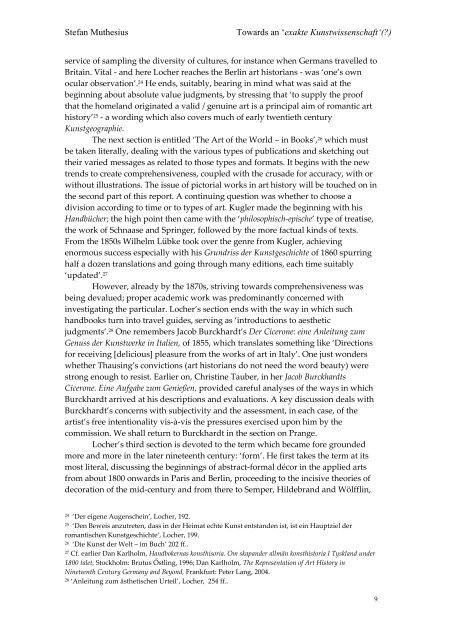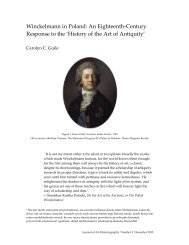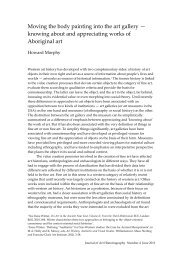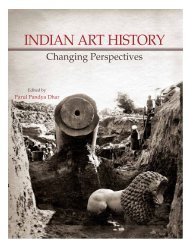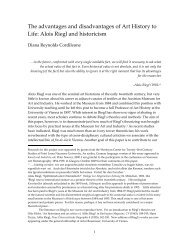9/SM1 - Journal of Art Historiography
9/SM1 - Journal of Art Historiography
9/SM1 - Journal of Art Historiography
You also want an ePaper? Increase the reach of your titles
YUMPU automatically turns print PDFs into web optimized ePapers that Google loves.
Stefan Muthesius<br />
Towards an ‘exakte Kunstwissenschaft‘(?)<br />
service <strong>of</strong> sampling the diversity <strong>of</strong> cultures, for instance when Germans travelled to<br />
Britain. Vital - and here Locher reaches the Berlin art historians - was ‘one’s own<br />
ocular observation’. 24 He ends, suitably, bearing in mind what was said at the<br />
beginning about absolute value judgments, by stressing that ‘to supply the pro<strong>of</strong><br />
that the homeland originated a valid / genuine art is a principal aim <strong>of</strong> romantic art<br />
history’ 25 - a wording which also covers much <strong>of</strong> early twentieth century<br />
Kunstgeographie.<br />
The next section is entitled ‘The <strong>Art</strong> <strong>of</strong> the World – in Books’, 26 which must<br />
be taken literally, dealing with the various types <strong>of</strong> publications and sketching out<br />
their varied messages as related to those types and formats. It begins with the new<br />
trends to create comprehensiveness, coupled with the crusade for accuracy, with or<br />
without illustrations. The issue <strong>of</strong> pictorial works in art history will be touched on in<br />
the second part <strong>of</strong> this report. A continuing question was whether to choose a<br />
division according to time or to types <strong>of</strong> art. Kugler made the beginning with his<br />
Handbücher; the high point then came with the ‘philosophisch-epische’ type <strong>of</strong> treatise,<br />
the work <strong>of</strong> Schnaase and Springer, followed by the more factual kinds <strong>of</strong> texts.<br />
From the 1850s Wilhelm Lübke took over the genre from Kugler, achieving<br />
enormous success especially with his Grundriss der Kunstgeschichte <strong>of</strong> 1860 spurring<br />
half a dozen translations and going through many editions, each time suitably<br />
‘updated’. 27<br />
However, already by the 1870s, striving towards comprehensiveness was<br />
being devalued; proper academic work was predominantly concerned with<br />
investigating the particular. Locher’s section ends with the way in which such<br />
handbooks turn into travel guides, serving as ‘introductions to aesthetic<br />
judgments’. 28 One remembers Jacob Burckhardt’s Der Cicerone: eine Anleitung zum<br />
Genuss der Kunstwerke in Italien, <strong>of</strong> 1855, which translates something like ‘Directions<br />
for receiving [delicious] pleasure from the works <strong>of</strong> art in Italy’. One just wonders<br />
whether Thausing’s convictions (art historians do not need the word beauty) were<br />
strong enough to resist. Earlier on, Christine Tauber, in her Jacob Burckhardts<br />
Cicerone. Eine Aufgabe zum Genießen, provided careful analyses <strong>of</strong> the ways in which<br />
Burckhardt arrived at his descriptions and evaluations. A key discussion deals with<br />
Burckhardt’s concerns with subjectivity and the assessment, in each case, <strong>of</strong> the<br />
artist’s free intentionality vis-à-vis the pressures exercised upon him by the<br />
commission. We shall return to Burckhardt in the section on Prange.<br />
Locher’s third section is devoted to the term which became fore grounded<br />
more and more in the later nineteenth century: ‘form’. He first takes the term at its<br />
most literal, discussing the beginnings <strong>of</strong> abstract-formal décor in the applied arts<br />
from about 1800 onwards in Paris and Berlin, proceeding to the incisive theories <strong>of</strong><br />
decoration <strong>of</strong> the mid-century and from there to Semper, Hildebrand and Wölfflin,<br />
24<br />
‘Der eigene Augenschein’, Locher, 192.<br />
25<br />
‘Den Beweis anzutreten, dass in der Heimat echte Kunst entstanden ist, ist ein Hauptziel der<br />
romantischen Kunstgeschichte’, Locher, 199.<br />
26<br />
‘Die Kunst der Welt – im Buch’ 202 ff..<br />
27<br />
Cf. earlier Dan Karlholm, Handbokernas konsthisoria. Om skapander allmän konsthistoria I Tyskland under<br />
1800 talet, Stockholm: Brutus Őstling, 1996; Dan Karlholm, The Representation <strong>of</strong> <strong>Art</strong> History in<br />
Nineteenth Century Germany and Beyond, Frankfurt: Peter Lang, 2004.<br />
28<br />
‘Anleitung zum ästhetischen Urteil’, Locher, 254 ff..<br />
9


